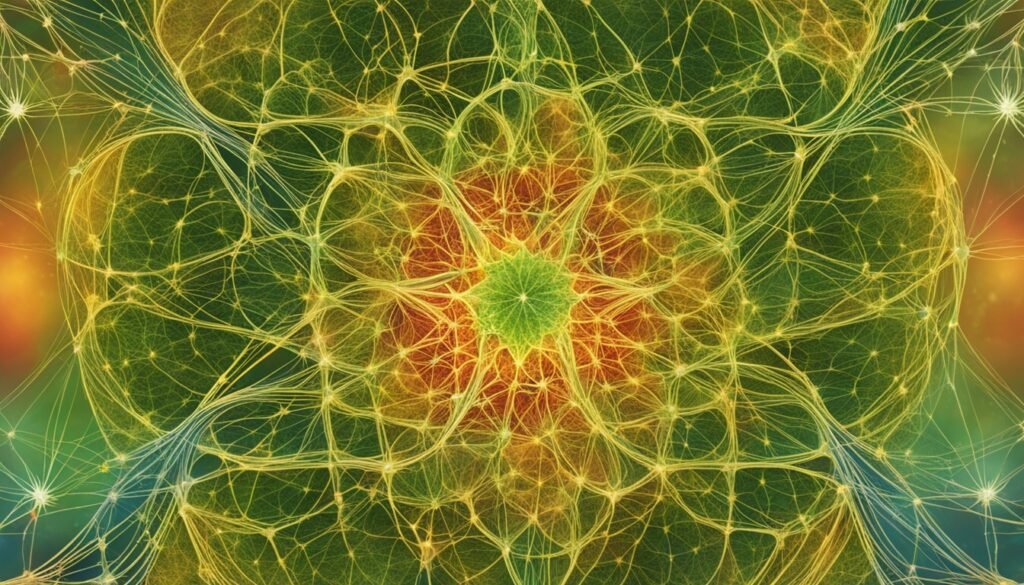Cannabis sativa has been used for thousands of years for health reasons. In 1985, companies got the green light to make THC treatments. This was a big step in bringing back cannabinoids into medicine. Now, we’re looking into another cannabinoid, CBD, for treating things like epilepsy and schizophrenia.
Today, 38 states and D.C. have made medicinal cannabis legal. But, it’s still not allowed under federal law in the U.S. This change in laws has helped us learn more about cannabis cannabinoids. We’re finding out about their benefits and how they work.

Key Takeaways
- Cannabis sativa has a long history as a medicinal plant, dating back over two millennia.
- Pharmaceutical companies began developing THC-based treatments in 1985, reintroducing cannabinoids into the medical field.
- Efforts are now being made to explore the potential of cannabidiol (CBD) as a treatment for various conditions.
- Medicinal cannabis is legal in 38 U.S. states and D.C., but remains illegal at the federal level.
- The shifting legal landscape has led to increased research and understanding of medicinal cannabinoids and their potential benefits.
What are Cannabinoids and the Endocannabinoid System?
The cannabis plant has many interesting compounds called cannabinoids. These chemicals, over 100 in number, cause the different effects we see with cannabis. THC and CBD are two main cannabinoids that work with our body’s endocannabinoid system in unique ways.
Overview of Cannabinoids in Cannabis
Cannabinoids in cannabis are like the endocannabinoids our bodies make. They can connect to the same receptors as our endocannabinoids, leading to various effects. The main cannabinoids in cannabis are:
- THC (tetrahydrocannabinol) – The main active part that makes people feel “high.”
- CBD (cannabidiol) – Doesn’t make you feel high but may help with pain and anxiety.
- CBN (cannabinol), CBG (cannabigerol), and others – Each has its own effects and ways of working in the body.
The Role of the Endocannabinoid System
The endocannabinoid system is a complex network that helps keep our body balanced. It deals with many functions like pain, mood, hunger, and immune health. It has endocannabinoids, receptors for them, and enzymes that make and break them down.
Cannabinoids from cannabis can affect this system. They can change its function and may help with health issues. Knowing how the endocannabinoid system works helps us understand how cannabinoids can be used for health.

Key Medicinal Cannabinoids: THC and CBD
Two main cannabinoids in cannabis are THC (tetrahydrocannabinol) and CBD (cannabidiol). They have different healing properties. This makes them the center of research on cannabis’s health benefits.
THC is known for making people feel high. But it also helps with pain and inflammation. This makes it good for treating chronic pain, muscle spasms, and other issues.
CBD doesn’t make you feel high. It’s known for its health benefits without the THC effects. It helps with inflammation, anxiety, and even some neurodegenerative diseases.

THC and CBD are being studied a lot for their health uses. Scientists look into how they can help with many health problems. Knowing about these cannabinoids helps doctors and patients choose cannabis-based treatments.
Health Benefits of Cannabinoids
Cannabinoids are active compounds in cannabis that have many health benefits. They are great for pain relief and anti-inflammatory effects.
Pain Relief and Anti-Inflammatory Effects
Research shows cannabinoids can ease pain in people with nerve damage, cancer, multiple sclerosis, and rheumatoid arthritis. They work with the body’s endocannabinoid system to manage pain and inflammation.
Cannabinoids also have anti-inflammatory properties that help with many health issues. They target inflammation to reduce symptoms like chronic pain, joint inflammation, and autoimmune diseases.
Neuroprotective and Anti-Seizure Properties
Cannabinoids protect and support the nervous system’s health. This is great for brain and nervous system conditions like neurodegenerative diseases, traumatic brain injuries, and stroke.
They also have anti-seizure properties, especially for rare childhood epilepsy types. The FDA approved a CBD product, Epidiolex, for these seizures. This shows how cannabinoids can help manage seizures and epilepsy.
Medicinal Cannabis Cannabinoids: Benefits and Effects
Medicinal cannabis is now a common treatment for many health issues. The benefits and effects vary based on the type of cannabinoid and the condition treated. Knowing how cannabis can help with health issues can guide patients in choosing their treatment.
Medicinal uses of cannabis include easing chronic pain. Cannabinoids like THC and CBD help reduce inflammation and pain. They are also used for treating multiple sclerosis, nausea during chemotherapy, weight loss in HIV/AIDS, and some seizure disorders.
| Medicinal Condition | Potential Benefits of Cannabis Cannabinoids |
|---|---|
| Chronic Pain | Anti-inflammatory and pain-relieving effects |
| Multiple Sclerosis | Muscle relaxation, reduced spasticity, and improved mobility |
| Chemotherapy-Induced Nausea and Vomiting | Antiemetic (anti-nausea) and appetite-stimulating effects |
| Anorexia and Weight Loss in HIV/AIDS | Appetite-stimulating and weight-gaining effects |
| Seizure Disorders | Anticonvulsant and neuroprotective properties |
The effects of cannabis cannabinoids differ by the cannabinoid type and how the body reacts. Patients should talk to their doctors to find the right cannabis product for their needs.
Choosing Cannabis Strains Based on Cannabinoid Profiles
Patients can pick cannabis strains based on their needs and the effects they want. Knowing the cannabinoid profiles of different strains helps patients choose the right one for their health issues.

High-THC Strains for Pain and Appetite Stimulation
Strains high in THC are popular for easing pain and boosting appetite. THC is the main psychoactive part of cannabis. It helps with pain and makes people hungrier. People with chronic pain or who have lost their appetite might find these strains helpful.
High-CBD Strains for Anxiety and Inflammation
Cannabidiol (CBD) is another important cannabinoid. It’s known for helping with anxiety and inflammation. High-CBD strains are good for those who want cannabis’s health benefits but don’t want the high from THC. CBD can reduce anxiety and inflammation, offering relief for these issues.
| Cannabinoid Profile | Medicinal Uses |
|---|---|
| High-THC Strains |
|
| High-CBD Strains |
|
Legal Status and Access to Medicinal Cannabis
In 2023, the legal status of medicinal cannabis is complex and changing in the U.S. 38 states and the District of Columbia allow medicinal cannabis use. But, it’s still illegal under federal law. This mix of state laws makes it hard for patients to get access to medicinal cannabis.
Each state has its own rules for medicinal cannabis. Some states limit THC content or only allow low-THC/high-CBD products. Others offer a wide range of options for patients.
Patients often find it hard to understand the laws. Getting a medical cannabis recommendation, joining state programs, and finding dispensaries is complicated. It takes a lot of time and effort.
Despite the hurdles, more people are accepting medicinal cannabis. They see its potential health benefits. As research grows, so will access and support for patients.
Potential Side Effects and Safety Considerations
Medicinal cannabis offers many benefits, but it’s key to know the possible side effects and safety points. This knowledge helps patients make smart choices and use it wisely.
Short-Term and Long-Term Risks
Short-term use might cause feelings of euphoria, changes in senses, and issues with memory and thinking. It can also make your heart beat faster. Long-term, it could harm attention, learning, and memory, especially in young people. It might also raise the chance of schizophrenia in those at risk.
Smoking cannabis can harm the lungs and increase the risk of stroke, heart disease, and blood vessel problems.
Contraindications and Precautions
- Pregnant women and those breastfeeding should not use medicinal cannabis. It could harm the baby.
- Those with a history of psychosis should be careful with it, as it might make things worse.
- People with heart issues need to be extra cautious, as cannabis can up the risk of heart attack.
Always talk to a healthcare professional before trying medicinal cannabis, especially if you have health issues or take other meds. Getting the right dose and how to take it is key to stay safe and avoid side effects.
Knowing the risks and precautions helps patients make safe and informed choices with medicinal cannabis.
Conclusion
Medicinal cannabis cannabinoids, like THC and CBD, have shown great promise. They help with pain, reduce inflammation, and may protect the brain and prevent seizures. As laws change, it’s important for patients and doctors to know about these therapies. This helps them make smart choices.
But, using medicinal cannabis comes with risks. We need to think about both the good and the bad effects. By understanding these risks, people can choose what’s best for their health.
The story of medicinal cannabis is hopeful but careful. Research keeps showing how these compounds can help us. Yet, we must use them wisely. The key is working together – patients, doctors, and lawmakers – for safe and smart use of these powerful substances.



